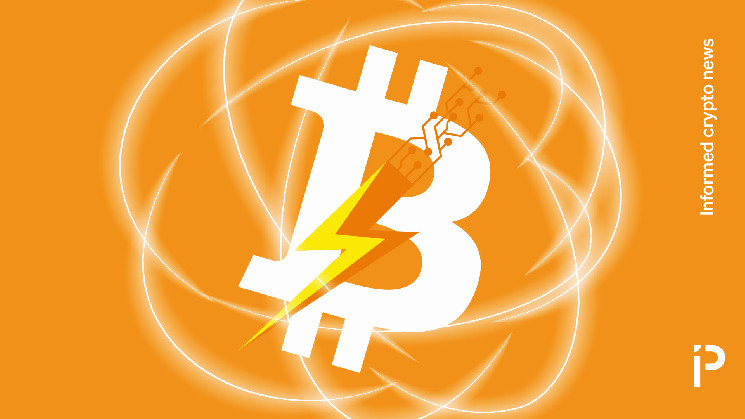Software engineer Tobi Ojuolape has published a method for making very large payments using Bitcoin’s Lightning Network. He recommends Lightning nodes upgrade to support atomic multipath payments (AMP).
This new specification would split a large payment, routing the full amount via multiple channels. However, the transaction would remain atomic, in other words, “indivisible and irreducible.”
An atomic transaction is all-or-nothing, guaranteeing that either all money settles or else nothing settles. Atomicity prevents the sender from losing any part of their bitcoin if any particular route fails.
Ojuolape’s AMP proposal is unexpected because the Lightning Network primarily handles small payments. Historically, research into large, Lightning payments has been neglected.
A brief introduction to Bitcoin’s Lightning Network
Lightning is the most popular scaling layer for Bitcoin. Scaling layers use the base (Layer 1) blockchain but also contain additional functionality. Collectively, scaling layers are known as ‘Layer 2s.’
- Lightning requires opening and funding a payment channel on-blockchain that can subsequently manage transactions off-chain.
- Lightning nodes connect to one another, forming a mesh network with various amounts of liquidity between all participants.
- Coins route across the network, with each node charging a very small fee for routing payments.
- The end result is a cheaper, faster routing of bitcoin payments.
- Trade-offs include security and decentralization, as Lightning transactions are not guaranteed by Bitcoin’s blockchain until users exit the network and settle on-chain.
Atomicity: How to safely send large payments via Lightning
Again, most Bitcoiners might view a technology to send a large payment via Lightning as counterintuitive. Why, they would ask, would anyone bother to use Lightning when a Layer 1 Bitcoin transaction would accomplish the same thing?
The vision for Lightning, however, is to expand Bitcoin as a financial system for the entire world’s population. Because Lightning routing fees are so much cheaper than Bitcoin’s base layer, the network could serve day-to-day needs for any amount of money, no matter how small or large.
From near-$0 as recently as 2019, Lightning now boasts over 17,000 nodes, 79,000 payment channels, and $150 million in capacity.
If this growth trend continues, Lightning will need a safe solution for routing large payments. Hence, Ojuolape’s AMP proposal.
The Lightning Network has made micropayments with Bitcoin fast and feasible, but what about larger payments?
— Toheeb Ojuolape (@toheebojuolape_) April 3, 2023
In this article, I explain AMPs – their use for large payments and how they compare with other payment options in Bitcoin and Lightning.https://t.co/231f7ctmZ5
Read more: Bitcoin Core developer proposes new type of pruned node
Bitcoin atomic multipath payments (AMPs)
LND v0.13.0-beta has introduced support for Atomic Multipath Payments. LND is one of the three most popular implementations of Lightning alongside Éclair and Core Lightning. Developers previously proposed and developed other protocols for multi-path payments, but AMP is the first to include atomicity.
AMPs add a new feature requiring atomicity. In other words, either all or zero payments must transmit; no partial execution of the transaction is allowed. If any payment as specified by the AMP sender does not settle, then nothing settles.
Atomicity avoids the risk of partial payments. While not a big deal when paying for a cup of coffee and losing a few cents, atomicity is critical when sending millions of dollars when that change could be worth many thousands of dollars.
Multipath payments eliminate the need to find a single channel with a large enough capacity to route the entire transaction. On an atomic basis, AMPs would raise the maximum size of a Lightning transaction from 14 bitcoin today into the thousands.
Read more: Bitcoin dev has fix for Lightning’s existential problem — offline payments
Atomic multipath ensures the whole payment gets through
Without multipath payments, sending bitcoin over the Lightning Network requires finding a single channel with sufficient capacity to route the entire payment if the sender does not want to trust multiple node operators.
Adding atomicity to multipath payments increases the security of this transaction by guaranteeing that the entire transaction settles, all at once.
Like all Lightning transactions, nodes supporting AMP would determine the best route for each data packet, ensuring that the full quantity reached its intended destination. This function reduces the risk of network congestion. Through AMP, senders can feel more secure about sending large payments without trusting too many node operators.
Tobi Ojuolape has described AMP as a method for making large Lightning Network payments without needing to find a single channel with sufficient capacity. Unlike other methods for multipath payments, atomic multipath payments ensure that the entire payment gets through without the risk of any lost change or partial payment.
 protos.com
protos.com
